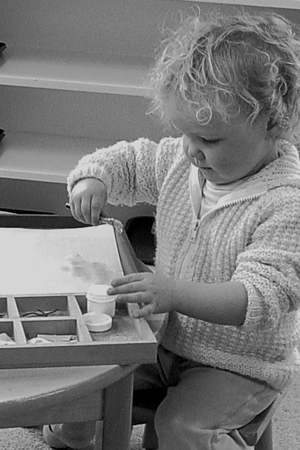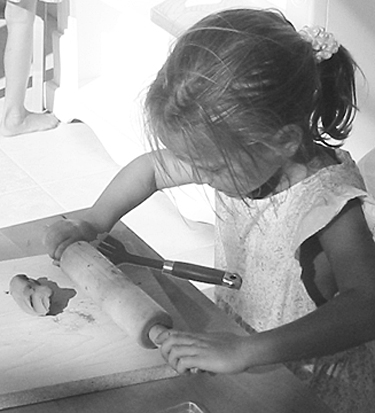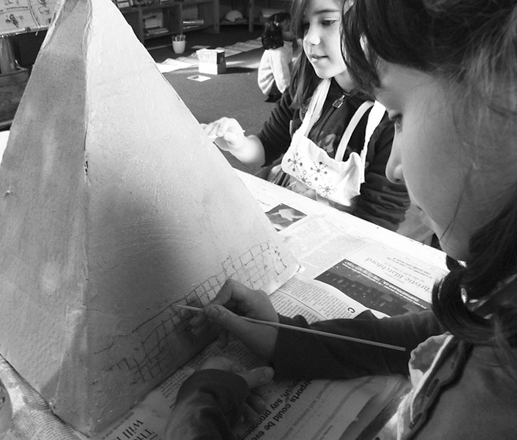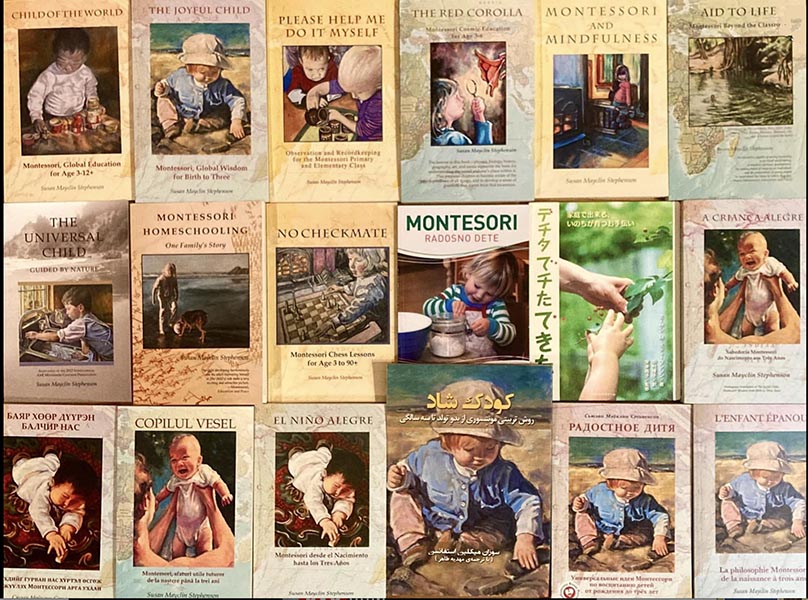ART & MONTESSORI From Birth to Age TwelveNewsletter #2: January, 2010 |
|---|
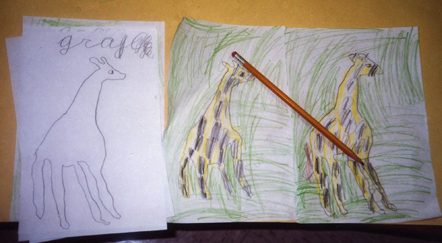 |
In the Montessori tradition it is the child's own original and unique art that is preferred over adult-generated forms to be colored in. This gives the child not only a very good self image, but skill at both observation and draftsmanship. As Dr. Montessori said, we cannot teach a person to be an artist but we can help him develop an eye that sees, a hand that obeys, and a soul that feels. |
ART for 0-3
|
ART for 3-6
|
ART for 6-12
|
Gluing box in the Infant Community |
Working with Plasticine in the Primary Class | Model pyramid made for student Egypt study presentation |
The First Year So let us provide the very best for the youngest, not only the pictures on the wall, but the mobiles that a child will watch, and any toys or rattles he will use in this first year. Here is the site for the loveliest mobiles and most beautiful toys that instill an appreciation of beauty early in life: AGE 1-3 ART MATERIALS It is fun to do special art projects in the home and infant community, but even at this young age children benefit from having a variety of art materials available to them at all times and a space to work, uninterrupted, when they are inspired. It is important to provide the best quality that we can afford—pencils, crayons, felt pens, clay, paper, brushes—and to teach the child how to use and care for them, and especially how to clean and put everything away so everything— the work space, the table and chair and the art materials—will be ready for the next great creative urge. ART APPRECIATION The same is true of the choice of toys, posters and other art work on the wall of the child's room and in the rest of the house, the dishes and cutlery, and the way objects are arranged in baskets on shelves, or hanging on hooks—creating order and beauty. Every part of the home influences the child's developing sense of beauty and balance, shape, and color. Reproductions of great masterpieces inspire an appreciation of beauty at any age. Great plant and animal art collections can be made from old calendars. These can be hung at the child's eye level in any part of the house—bedrooms, bathroom, even the laundry room and garage. ART LESSONS AUTHOR'S WEBSITE, Montessori work over the years, art and international blog, SUSAN MICHAEL OLAF Montessori information MICHAEL OLAF MICHAEL OLAF Montessori shop BOOKS & MATERIAL This page was updated on May 10, 2022
|
The truth is that when a free spirit exists, it has to materialize itself in some form of work, and for this the hands are needed. Everywhere we find traces of men's handiwork, and through these we can catch a glimpse of his spirit and the thoughts of his time. The skill of man's hand is bound up with the development of his mind, and in the light of history we see it connected with the development of civilization. NOTE: The AMI Montessori primary course art lectures, with skills developed now and used in the elementary class, can be found here The Red Corolla. Art is essential in the environment of the child from birth on. It is a way of approaching life, of moving and speaking, of decorating a home or school, of selecting toys and books. It cannot be separated from every other element of life. ART ACTIVITIES Just as any other activity in the 3-6 class, each art activity is kept complete and ready for use. If a child is interested in painting for example, he will find an apron, paper, paints and brushes, all clean and ready. After watching a seed grow into a plant a child might be inspired to draw the plant, to make leaf rubbings, to make a sculpture of a plant, or to create an original work in watercolor or tempera paints. Building with blocks, visiting a museum, listening to or making music, eating ethnic food, any activity can lead naturally to an artistic creation by the child. ART MATERIALS ART APPRECIATION and ART HISTORY Stories about artists, especially as children, are interesting for children. Good art books, even art books for adults, can engage a child for hours. At home or in the classroom, we can designate a "museum" table or shelf where beautiful art objects can be placed as a temporary art exhibit. Since everything else in the room is available for handling, this gives practice in just looking, as in a real museum, and allows close exposure to special items and beautiful objects that the child might not otherwise have. This also introduces the idea that most "art" objects in museums were used in daily life, soup bowls, jewelry, tools, and other useful and decorative creations.
These books are based on the author's fifty years of experience as a Montessori teacher and administrator, speaker, school consultant, and examiner for Montessori teacher training courses. Many have been translated into other languages. QUOTING BOOKS SHARE BY EMAIL Forward to friends SHARE ON FACEBOOK Share on FaceBook
|
Imagination does not become great until a person, given the courage and strength, uses it to create. If this does not occur, the imagination addresses itself only to a spirit wandering in emptiness. All of the academic work in the elementary class is connected with and expressed by means of the arts. Instead of unrelated art and music lessons for the few, the techniques of creating in all areas (art, music, drama, dance, etc.) are taught by the teacher (often with the help of parents or specialists, but only when called upon by the students, for a reason), and then used to make learning exciting. There might be a play acting out the process of photosynthesis or the population of the world, a quilt made with squares of leaf shapes as a school fundraiser, or a series of beautiful watercolors demonstrating the principles of geometry. Just as in all areas, the teacher is in charge of teaching the tools and the students of designing and executing the work. When we look at the curricula of the past, the Greeks and the Tibetans for example, we see that music and dance, and the arts in general, were an important part of the classical education. This was developed over many years of trial and error. It was considered "back to the basics," perhaps because they had discovered that purely mental learning did not stick in the mind, and that the arts allowed a student to enjoy learning, instead of just cramming in facts for a test. Maybe they discovered that learning that was fun and creative was remembered and that children who look forward to enjoying school have a better chance of being successfully educated. When information is processed in some active, musical or artistic way—graphs, posters, drawings, creating maps, songs, plays, and so forth, the knowledge becomes permanent and it strengthens the creative part of the brain. Processing means The Arts! A student becomes interested in a topic, with the teacher or a few friends she designs the research, then settles down to read and gather information. Most projects are, in the end, presented to the group in some form. Part of the group plan may be to decide who will do the art, the costumes, the music. Or an individual may work on something and present it as a song or poem, or a sculpted model. The work, whether it be in the field of geography, biography, history, math, or language takes the form of a project where the head and hand work together toward a creative, artistic expression. In order to learn in this way the child needs the tools and uninterrupted time. The adult supplies art materials, the model, such as exposure to good music or art, long blocks of uninterrupted time, and respect for the child's ideas and expression. When a child learns by combining academics and the arts the whole understanding of life—and development of the brain—makes a giant leap. There are no limits to avenues of creativity. Not only are famous artists and musicians studied, but ordinary people who bring the arts into their everyday lives. A child might interview parents, teachers, grandparents, to see what art forms they pursue as hobbies, what they did as children, and what are their dreams. One school we know selects a group art creation every year and auctions it off to raise class trip funds. Studying the creations of other cultures, experiencing their dances and music, studying the reasons why different architectural forms developed, and clothing or language, gives a child an understanding of the universality of human needs and expression. When elementary-aged children reach adolescence they enter one of the most creative periods of life, and will create based on those talents they have begun to develop in these earlier years. The period of life between the age of six and twelve is the time to explore as many creative forms as possible. Newsletters announcing books #13 Book, Child of the World: Montessori, Global Education for Age 3-12+, March 2013 #23 Book, Montessori and Mindfulness, November 2017 #25 Book, The Red Corolla, Montessori Cosmic Education (preparation in the 3-6 class), June 2019 Other Newsletters of interest |
